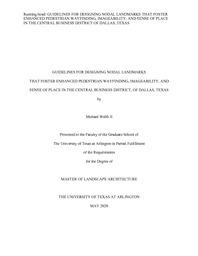
ATTENTION: The works hosted here are being migrated to a new repository that will consolidate resources, improve discoverability, and better show UTA's research impact on the global community. We will update authors as the migration progresses. Please see MavMatrix for more information.
Show simple item record
| dc.contributor.advisor | Hopman, David | |
| dc.creator | Webb, Michael A | |
| dc.date.accessioned | 2020-06-15T14:43:21Z | |
| dc.date.available | 2020-06-15T14:43:21Z | |
| dc.date.created | 2020-05 | |
| dc.date.issued | 2020-06-05 | |
| dc.date.submitted | May 2020 | |
| dc.identifier.uri | http://hdl.handle.net/10106/29147 | |
| dc.description.abstract | City nodes are designed and used to help improve a city’s wayfinding, imageability, and sense of place. If these nodes lack evidence-based image creation and navigation facilitation design parameters, the result is often disorientation within the urban environment. This research through design thesis suggests that the Central Business District of Dallas, Texas is an ideal location for proposed design improvements. Backed by a review of literature, survey responses, behavioral observations, and research-through design, a problematic node was chosen for a detailed design proposal to improve the wayfinding, imageability, and sense of place within the West End Historic District of Dallas, Texas. | |
| dc.format.mimetype | application/pdf | |
| dc.language.iso | en_US | |
| dc.subject | Node | |
| dc.subject | Wayfinding | |
| dc.subject | Imageability | |
| dc.subject | Sense of Place | |
| dc.subject | Landmark | |
| dc.subject | Design Thesis | |
| dc.title | Guidelines for designing nodal landmarks that foster enhanced pedestrian wayfinding, imageability, and sense of place in the Central Business District, of Dallas, Texas | |
| dc.type | Thesis | |
| dc.degree.department | Landscape Architecture | |
| dc.degree.name | Master of Landscape Architecture | |
| dc.date.updated | 2020-06-15T14:43:22Z | |
| thesis.degree.department | Landscape Architecture | |
| thesis.degree.grantor | The University of Texas at Arlington | |
| thesis.degree.level | Masters | |
| thesis.degree.name | Master of Landscape Architecture | |
| dc.type.material | text | |
| dc.creator.orcid | 0000-0003-1196-7068 | |
Files in this item
- Name:
- WEBB-THESIS-2020.pdf
- Size:
- 209.9Mb
- Format:
- PDF
This item appears in the following Collection(s)
Show simple item record


